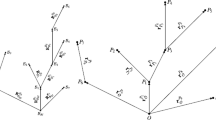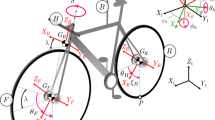Abstract
Vehicle dynamics has been an active field of research for many decades. The well-known single-track model already introduced in 1940 by Riekert and Schunck is still used to explain fundamental effects in vehicle dynamics such as under- and oversteering. However, meanwhile also very complex multibody dynamics models exist, which allow very detailed simulations. On the other hand, real-time computations necessary for active safety and driver assistance systems are demanded for models of lower complexity. As important effects at the handling limits are not covered by the linear single-track model, but complex multibody models cannot be integrated fast enough by electronic control units of safety systems, models with an adjustable degree of complexity are desired. As an example, model-predictive control is an upcoming field of application and relies on models that are integrated over the prediction horizon. Therefore, the selection of an appropriate model is an important task. The crux of the matter is to make a compromise between computation time and accuracy of the model having only a rough guess of the accuracy of the model. In this contribution a systematic approach is proposed. Instead of selecting an existing model, which is supposed to match requirements in computation time and level of detail, a complex model is reduced to match the requirements using symbolic model reduction techniques. This approach has two major advantages: First, the accuracy can be set by the user. Second, the model is continuously adjustable in its complexity or propagation precision.
Similar content being viewed by others
References
Borchers, C.: Symbolic behavioral model generation of nonlinear analog circuits. IEEE Trans. Circuits Syst. II, Analog Digit. Signal Process. 45(10), 1362–1371 (1998)
Brenan, K.E., Campbell, S.L.V., Petzold, L.R.: Numerical solution of Initial-Value Problems in Differential-Algebraic Equations. Society for Industrial Mathematics, Philadelphia (1996)
Burgermeister, B., Arnold, A., Eichberger, A.: Smooth velocity approximation for constrained systems in real-time simulation. In: Proceedings of the ECCOMAS Thematic Conference in Multibody Dynamics, Warsaw, Poland (2009)
Fritzson, P., Aronsson, P., Bunus, P., Engelson, V., Saldamli, L., Johansson, H.: The open source Modelica project. In: Proceedings of the 2nd International Modelica Conference, Oberpfaffenhofen, Germany (2002)
Gorban, A.N., Kazantzis, N., Kevrekidis, I.G., Ottinger, H.C., Theodoropoulos, C.: Model Reduction and Coarse-Graining Approaches for Multiscale Phenomena. Springer, Berlin, Heidelberg (2006)
Hindmarsh, A.C., Brown, P.N., Grant, K.E., Lee, S.L., Serban, R., Shumaker, D.E., Woodward, C.S.: SUNDIALS: suite of nonlinear and differential-algebraic equation solvers. ACM Trans. Math. Softw. 31(3), 363–396 (2005)
Mikelsons, L., Ji, H., Brandt, T., Lenord, O.: Symbolic model reduction applied to real-time simulation of a construction machine. In: Proceedings of the 7th International Modelica Conference, Como, Italy (2009)
Pacejka, H.B.: Tyre and Vehicle Dynamics. Butterworth-Heinemann, Oxford (2006)
Popp, K., Schiehlen, W.: Ground Vehicle Dynamics. Springer, Berlin, Heidelberg (2010)
Riekert, P., Schunck, T.: Zur Fahrmechanik des gummibereiften Kraftfahrzeugs. Arch. Appl. Mech. 11(3), 210–224 (1940)
Sommer, R., Halfmann, T., Broz, J.: Automated behavioral modeling and analytical model-order reduction by application of symbolic circuit analysis for multi-physical systems. Simul. Model. Pract. Theory 16(8), 1024–1039 (2008)
Wichmann, T.: Computer aided generation of approximate DAE systems for symbolic analog circuit design. J. Appl. Math. Mech. 81, 633–644 (2000)
Wichmann, T.: Transient ranking methods for the simplification of nonlinear DAE systems in analog circuit design. Proc. Appl. Math. Mech. 2(1), 448–449 (2003)
Wichmnann, T.: Symbolische Reduktionsverfahren für nichtlineare DAE-Systeme. Ph.D. thesis, Technische Universität Kaiserslautern, Germany (2004)
Author information
Authors and Affiliations
Corresponding author
Rights and permissions
About this article
Cite this article
Mikelsons, L., Brandt, T. Generation of continuously adjustable vehicle models using symbolic reduction methods. Multibody Syst Dyn 26, 153–173 (2011). https://doi.org/10.1007/s11044-011-9247-x
Received:
Accepted:
Published:
Issue Date:
DOI: https://doi.org/10.1007/s11044-011-9247-x




